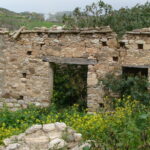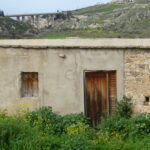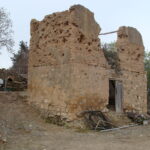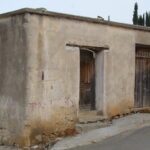It was initially a village of Christians
According to the Ottoman taxation archives of 1572, Agia Varvara existed during that year as a small village, which included 20 non-Muslim inhabited houses1M. Akif Erdoğru - Population and agricultural productions in the district of Paphos (Baf) of Cyprus in 1572, Archivum Ottomanicum 32 (2015). As its name implies (Saint Varvara), it was a village dedicated to that female saint, and it was founded before the Ottomans arrived in 1571. The Muslims abolished the Christian name of "Agia Varvara" in 19582http://www.prio-cyprus-displacement.net/default.asp?id=471 and used "Engindere" instead, which means "vast stream", which refers to the torrent of Ezousa.
The plague may be a reason why Agia Varvara was inhabited by Muslims
William Turner in 18153Claude Delaval Cobham - Excerpta Cypria, 1895 mentions that Agia Varvara was at that time uninhabited due to deaths occurred by the plague: "On the beginning of it we passed the small village of S. Barbara, whose inhabitants were every one of them swept off by the plague two years ago". Here we have two possibilities:
- The inhabitants during the plague were already Christians converted on their entity to Islam, the survivors abandoned it and returned back later. This is the most possible scenario.
- The Christian population of Agia Varvara in Pafos was wiped out by the plague at the beginning of the 19th century and the survivors -if any- abandoned it. At some point later, when health conditions returned in the region, Agia Varvara was once again inhabited, but this time by Muslims. It is doubtful to consider that within 63 years (from 1815 until 1878), Christians reinhabited this village and converted to Islam in such a short period of time.
The village remained uninhabited at least until 1831 since for the census of that year no inhabitants were recorded4http://www.prio-cyprus-displacement.net/default.asp?id=471.
How Agia Varvara was developed into a "mixed" village
I interviewed some residents in 20085Petrou Christos - Ταξίδια εντός Κύπρου σε 45 χωριά, μεταξύ 2008-2010, 2016. Locals told me that according to the deceased Ibrahim Mustafa, the property of the village was controlled by the Muslims. To those, Christians from the nearby Episkopi (of Pafos) village used to come and work for. The Muslims offered the Episkopi villagers work of agricultural and livestock nature. According to Ibrahim Mustafa, the rich Muslims were helping the newlywed Christians by sparing to them 5-6 sheep. Those Christians were building their small home in Agia Varvara, and that was the reason that later on the village was developed into a mixed community of Muslims and Christians. Not all the Christians were former Episkopi residents, though. As we see the relations between the Muslims and their Christian employees were, as it seems, friendly. In fact, so much peaceful that in 1872, the Muslims allowed the Christians to erect the church of Agia Varvara.
When the Christians abandoned Agia Varvara
According to Ibrahim Mustafa's stories told to the later generation6Petrou Christos - Ταξίδια εντός Κύπρου σε 45 χωριά, μεταξύ 2008-2010, 2016, in 1964, when the hostilities between Christians and Muslims occurred in Cyprus, around 60 families lived in the community, equally divided among the two religious groups. The Christians (or Greek Cypriots as they were named after 1960), felt threatened by the Muslim element and abandoned the village, due to the fact that the Turkish Cypriots were at that time already armed with weapons (we see on one of the images the initials "TMT"7TMT stands for Türk Mukavemet Teşkilatı (Turkish Resistance Organisation) which was a Turkish Cypriot pro-taksim paramilitary organisation formed by Rauf Denktaş and Turkish military officer Rıza Vuruşkan in 1958 as an organisation to counter the Greek Cypriot Fighter's Organization EOKA who was formed to get rid of the English colonizers and unify Cyprus with Greece with red paint on the wall). Only seven Greek Cypriot families remained in Agia Varvara, while the rest left without returning in the next decades. In 1975, during the population exchange between the two communities of the south and north, the Turkish Cypriots also abandoned Agia Varvara, forever...
Greek Cypriot refugees arrive in Agia Varvara
In 1975, Greek Cypriot refugees arrived in Agia Varvara from various locations of the north. One of them was Martha Tsimouri, who told me in 20088Petrou Christos - Ταξίδια εντός Κύπρου σε 45 χωριά, μεταξύ 2008-2010, 2016: "When I arrived here I found my new village in a mess. I was glazing at it and I was crying, it reminded nothing to me of Lapythos. It had no roads, no buses. Dozens of times I needed to take my kids to the hospital and each time we walked two kilometres to Acheleia and from there, we hitch-hiked so that someone would carry us to the hospital. Only two cars existed in Agia Varvara. Even when our kids grew up and were taught lessons in Yeroskipou, the driver was letting them in Acheleia because the bus's route did not include our village".
The modern development of the village
According to the residents9Petrou Christos - Ταξίδια εντός Κύπρου σε 45 χωριά, μεταξύ 2008-2010, 2016, the development of Agia Varvara began after 2000, when the first modern residents started to appear. New families inhabited Agia Varvara as the village is only 17 kilometres away from the Pafos centre.







